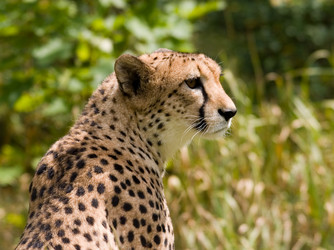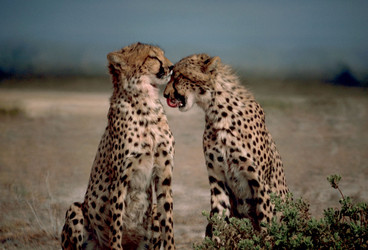

Acinonyx jubatus portrait. © 2007 Mark Probst
Organism:
The cheetah is a big cat and is now, mainly found in southern Africa. It is known for its speed as it is able to accelerate from 0-60 miles per hour in only three seconds, and it is able to reach speeds of around 70 miles per hour (112 kilometers per hour). In comparison, the cheetah is able to accelerate from 0-60 miles per hour almost one second faster than a Lamborghini Gallardo (3.95 seconds). This makes the cheetah the fastest land animal. Cheetahs are carnivourous animals that prey on gazelles, impala, hares, and even larger animals such as zebra and wildebeests. Cheetahs are diurnal hunters, as they hunt during the day and rest at night. This is because they mainly use their sight for hunting, rather than scent. Although cheetahs are hunters, they are occasionally hunted by other big cats such as lions, Nile crocodiles, spotted hyenas, and even leopards.
Habitat:
Cheetahs used to be able to be found throughout all of Africa, and even into India. Now, they are mainly found in southern Africa, below the Sahara Desert. In this area, cheetahs may be found in open plains, savannah, open woodland, and semi-barren zones. They have also been known to live in areas of dense vegetation, and even mountainous terrain.
Adaptations:
As opposed to other big cats such as the lion, tiger, and leopard, the cheetah lacks the ability to roar, and does not possess very good climbing skills. Instead, its body is built for speed, with various adaptations for it. These adaptations include enlarged nostrils for increased oxygen intake and enlarged heart and lungs to help move the large amount of oxygen in the body more efficiently. Cheetahs are longer and more slender with longer legs than other big cats. Other adaptations for speed and agility include semi-detractrable claws for superior traction, a long, flat tail used as an assist for stability in making sharp turns at high speeds, and a flexible spine that acts a spring, giving the cheetah more power. Besides being adapted for speed and agility, the cheetah possesses other adaptations that allow for better hunting skill. These include the black `teardrop` marks from the corner of the eyes to the the mouth in order to help keep the sun out of its eyes. Cheetahs have high-set, forward facing eyes that allow for better sight and stalking of prey. The distinct cheetah hide is characterized by black dots on a beige background and offers some camouflage while hunting.
Reproductive Characteristics and Life Cycle:
In the wild, cheetahs are able to live up to twelve years old, and in captivity, they can reach ages of twenty. Males reach sexual maturity within twelve months of birth, and females reach sexual maturity in about twice this time, twenty to twenty-four months. There is no specific time of the year when cheetahs will mate. Females are sexually promiscuous as they frequently have cubs with different males. The gestation period is about 90-98 days, after which the cubs are born. These litters are usually around three to five cubs, but can be as many as nine. The cubs are born between 150 and 300 grams, and are born with their characteristic spots, as well as a mantle extending to mid-back. As the cheetah grows older, this mantle is shed. The mother will look after her young for at least thirteen months, and at the most, twenty months. For the most part, females will live by themselves, except when they have cubs, whereas male cheetahs will rarely live alone. Instead they can form life long bonds and form a coalition with up to six other male cheetahs, often brothers.


Pair of cheetahs, Acinonyx jubatus. Photo by Gary M. Stolz
Classification:
- Kingdom: Animalia
- Phylum: Chordata
- Class: Mammalia
- Order: Carnivora
- Family: Felidae
- Genus: Acinonyx
- Species: Acinonyx jubatus
Conservation Status:
Cheetahs are in an endangered state and are considered to be facing a very high risk of extinction in the wild. This is due the high mortality rate among cheetah cubs. The reason for this is in part due to a history of inbreeding among cheetahs, leading to low genetic diversity and low resistance to disease.
Importance to the Ecosystem:
The cheetah is important to its ecosystem because it keeps the animals that it hunts in check. By hunting and killing off its prey they ensure that the populations of those species do not enlarge to the point where they are eating all the vegetation, ruining the soil, by letting it be leeched of its nutrients and breaking down the entire food chain and subsequently the ecosystem. Also cheetahs will hunt and kill the easier prey, namely the animals that are the slowest, least intelligent etc. By doing so the cheetah are not allowing the slow or weaker genes to be spread to the next generation maintaining the strength and stability of the species.
Information on the Internet
- Cheetah BBC.com. Accessed 10 Sept. 2008
- Cheetah C., Carolyn. Accessed 14 Sept. 2008
- Facts About the Cheetah Natural-Track.com. 2001. Accessed 14 Sept. 2008
- CheetahSpot.com Marin, Cheech. Accessed 14 Sept. 2008
- Cheetah, Fast, Agile Wild Cat ... Underdog Of The African Plains Roocroft, Gareth. South African Game Reserves. Accessed 12 Sept. 2008



 Go to quick links
Go to quick search
Go to navigation for this section of the ToL site
Go to detailed links for the ToL site
Go to quick links
Go to quick search
Go to navigation for this section of the ToL site
Go to detailed links for the ToL site